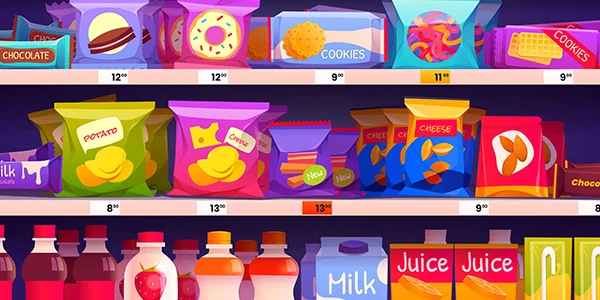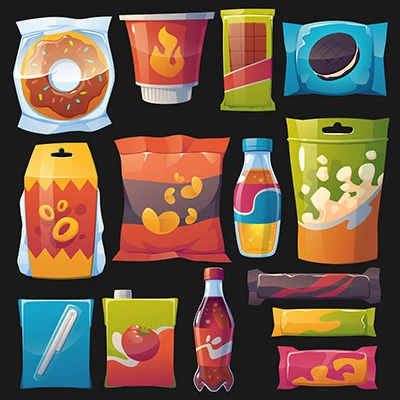Packaged Foods: also known as processed foods, refer to food products that have undergone various manufacturing, processing, or packaging steps before reaching consumers. These foods are typically sold in pre-packaged containers, such as cans, boxes, bottles, bags, or other forms of packaging. Packaged foods can include a wide range of products, from simple items like canned vegetables and bottled water to more complex processed foods like frozen dinners, snack foods, and ready-to-eat meals.
Types of Packaged Foods
Packaged foods encompass a wide variety of products, ranging from basic staples to highly processed convenience items.
Here are some common types of packaged foods:
- Canned Foods: These are foods that have been preserved and sealed in cans. Examples include canned vegetables, fruits, soups, and meats.
- Frozen Foods: These foods are kept in a frozen state to maintain freshness. Common examples include frozen fruits and vegetables, frozen pizzas, frozen entrees, and ice cream.
- Bakery Products: This category includes packaged bread, pastries, muffins, and other baked goods that come in plastic bags or cardboard containers.
- Dairy Products: Packaged dairy products encompass milk, yogurt, cheese, and butter, often sold in cartons, containers, or plastic-wrapped portions.
- Cereals: Breakfast cereals are typically packaged in boxes or bags and come in various forms like flakes, puffs, or granola.
- Snack Foods: These include chips, pretzels, popcorn, crackers, and a wide array of other savory or sweet snacks, usually in bags or snack-sized containers.
- Beverages: Beverages come in various packaging types, including cans, bottles, cartons, and pouches. Examples include soda, juice, bottled water, energy drinks, and coffee.
- Condiments and Sauces: Items like ketchup, mustard, mayonnaise, salad dressings, and various sauces are often sold in bottles, jars, or squeeze tubes.
- Canned Soups and Broths: These are ready-to-eat or cooking-ready soups and broths packaged in cans or cartons.
- Pasta and Rice: Packaged pasta and rice products come in boxes, bags, or plastic containers.
- Baking Ingredients: Items like flour, sugar, cake mixes, and baking powder are packaged in various-sized bags or boxes.
- Canned or Jarred Seafood: This category includes products like canned tuna, sardines, and jarred anchovies.
- Breakfast Bars and Granola Bars: These convenient snacks are often individually wrapped and sold in boxes.
- Ready-to-Eat Meals: These are complete meals or entrees packaged in microwave-safe containers, such as TV dinners, frozen pizza, and pre-packaged salads.
- BabyFood: Specially formulated foods for infants and toddlers are packaged in jars, pouches, or containers.
- Pet Food: Packaged foods for pets come in various forms, including dry kibble, canned, and semi-moist options.
- Sweets and Candy: Candy bars, chocolates, gummy candies, and other sweets are typically sold in wrappers or bags.
- Nutritional Supplements: Products like protein powder, vitamins, and minerals are often sold in jars, tubs, or capsules.
- Instant Foods: These include instant noodles, instant oatmeal, and other foods designed for quick and easy preparation.
- Cooking Oils: Various cooking oils, such as vegetable oil, olive oil, and coconut oil, are packaged in bottles or containers.
It’s important to note that while many packaged foods provide convenience, they can also vary widely in terms of their nutritional value and processing level. Consumers should read labels and make informed choices to maintain a balanced diet.

Benefits of Packaged Foods
Packaged foods offer several benefits, which is why they have become a significant part of modern diets. However, it’s important to note that the nutritional value and health benefits of packaged foods can vary widely depending on the specific product.
Here are some potential benefits of packaged foods:
- Convenience: Packaged foods are convenient and require minimal preparation or cooking. This is especially helpful for people with busy lifestyles or limited cooking skills.
- Long Shelf Life: Many packaged foods are designed to have a long shelf life, reducing food waste and allowing consumers to stock up on non-perishable items.
- Portion Control: Packaged foods often come in pre-portioned servings, making it easier for individuals to manage portion sizes and calorie intake.
- Nutritional Information: Most packaged foods are required to provide detailed nutritional information on the packaging, helping consumers make informed choices about their food purchases.
- Accessibility: Packaged foods are readily available in supermarkets, convenience stores, and online, making them accessible to a wide range of consumers.
- Variety: Packaged foods offer a wide variety of choices, including options for different dietary preferences, such as vegetarian, vegan, gluten-free, and low-sugar diets.
- Safety: Packaging helps protect food from contamination and spoilage, reducing the risk of foodborne illnesses.
- Transportability: Packaged foods are easy to transport and store, making them suitable for on-the-go consumption and travel.
- Reduced Prep Time: Packaged foods often save time in meal preparation, as they may require only minimal cooking or assembly.
- Innovation: The packaged food industry continually innovates, introducing new flavors, ingredients, and cooking techniques that can add diversity and excitement to one’s diet.
- Specialized Dietary Needs: Packaged foods can cater to specific dietary needs, such as low-sodium, high-fiber, or low-calorie options, making it easier for individuals with dietary restrictions to find suitable products.
- Emergency Preparedness: Having a stock of packaged foods can be helpful during emergencies or natural disasters when access to fresh food may be limited.
While packaged foods offer these benefits, it’s important to exercise caution and make informed choices. Not all packaged foods are equally nutritious, and some may be high in salt, sugar, unhealthy fats, or additives. Reading labels, understanding nutritional information, and incorporating a variety of fresh and minimally processed foods into one’s diet are essential for maintaining a balanced and healthy eating pattern.
What is the purpose of packaging food?
The purpose of packaging food serves several important functions, including:
- Preservation: Packaging helps to extend the shelf life of food products by protecting them from external factors such as air, moisture, light, and microorganisms. This preservation function helps prevent spoilage, maintain product freshness, and reduce food waste.
- Protection: Packaging provides a protective barrier that safeguards food from physical damage during handling, transportation, and storage. It helps prevent contamination, breakage, and exposure to harmful substances.
- Information and Communication: Packaging serves as a means of conveying essential information to consumers, such as product name, ingredients, nutritional content, allergen warnings, preparation instructions, expiration dates, and more. This information helps consumers make informed choices and ensures food safety.
- Convenience: Packaging makes food products more convenient to use and handle. It can include features like resealable closures, portion control, easy-to-open designs, and microwave-safe materials that enhance the user experience.
- Branding and Marketing: Packaging plays a crucial role in brand identity and marketing. Attractive and distinctive packaging can help products stand out on store shelves, communicate the brand’s values and image, and attract consumers’ attention.
- Transportation and Distribution: Packaging facilitates the efficient distribution of food products from manufacturers to retailers and ultimately to consumers. It helps organize and protect products during transit, reducing the risk of damage or spoilage.
- Regulatory Compliance: Packaging must adhere to various food safety and labeling regulations imposed by government agencies to ensure that food products meet specific quality and safety standards. Proper packaging helps companies comply with these regulations.
- Portion Control: Packaging can be designed to provide specific portion sizes, helping consumers manage their food intake and maintain a balanced diet.
- Sustainability: Sustainable packaging practices, such as reducing packaging waste, using recyclable or biodegradable materials, and minimizing excess packaging, contribute to environmental conservation and reduce the carbon footprint of the food industry.
- Convenience and Portability: Packaging often makes it easier for consumers to transport and consume food on the go. Single-serving packages and convenient designs cater to busy lifestyles.
In summary, packaging food serves a multifaceted purpose that goes beyond simple containment. It plays a critical role in preserving food quality, ensuring food safety, providing information to consumers, and contributing to branding and marketing efforts, while also addressing convenience, transportation, and regulatory requirements. Additionally, an increasing focus on sustainability has led to innovations in eco-friendly packaging solutions to reduce environmental impact.

Is packed food good for health?
The healthiness of packaged or processed food varies significantly depending on the specific product, its ingredients, and how it’s processed and packaged.
There is no one-size-fits-all answer to whether packed food is good or bad for health because it depends on several factors:
- Nutritional Content: Some packaged foods can be a part of a healthy diet when they contain essential nutrients like vitamins, minerals, fiber, and protein in appropriate amounts. Examples include frozen vegetables, canned beans, and whole-grain cereals.
- Processedvs. Ultra-Processed: Not all packaged foods are created equal. Highly processed or ultra-processed foods often contain high levels of added sugars, unhealthy fats, salt, and a variety of additives. These can be detrimental to health when consumed in excess. Examples include sugary snacks, sugary drinks, and many fast-food items.
- Portion Size: The portion size and serving of packaged foods matter. Even a healthy food can be unhealthy if consumed in excessive amounts. Pay attention to portion sizes and recommended serving sizes on packaging.
- Added Sugars and Salt: Many packaged foods contain added sugars and salt, which can contribute to health problems when consumed in excess. Be mindful of the sugar and sodium content in packaged foods.
- Ingredients: Read ingredient lists. Foods with a long list of artificial additives, preservatives, and chemicals may be less healthy than those with a shorter list of recognizable, natural ingredients.
- Nutrition Labels: Check the Nutrition Facts label for information on calories, fat, saturated fat, trans fat, cholesterol, fiber, sugar, and sodium. This label provides valuable information about the nutritional content of the product.
- Processing Methods: The way food is processed can impact its nutritional value. For example, foods that are heavily refined or fried may lose some of their nutritional value.
- Packaging Type: The packaging itself can influence food safety and quality. Properly sealed and stored packaging can help preserve the freshness and safety of the food.
In general, it’s advisable to prioritize whole, minimally processed foods in your diet, such as fruits, vegetables, whole grains, lean proteins, and dairy products. However, not all packaged foods are inherently unhealthy. Many packaged foods, when chosen wisely, can be a convenient and practical part of a balanced diet. To make informed choices, it’s essential to read labels, understand nutritional content, and be mindful of portion sizes. Additionally, it’s a good practice to limit the consumption of highly processed and unhealthy packaged foods that are high in added sugars, unhealthy fats, and sodium. Moderation and balance are key principles for a healthy diet.





